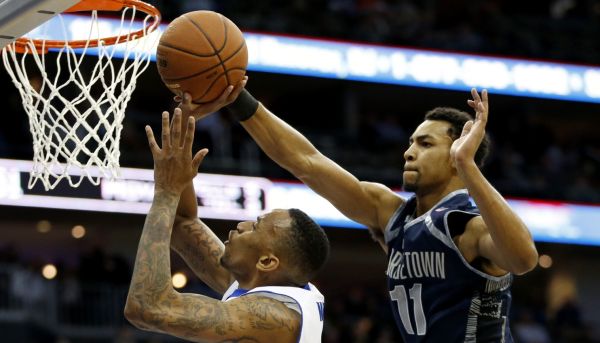Behind a Cloudy Georgetown Start Emerges a Shining Sophomore
Posted by Justin Kundrat on November 23rd, 2015As with any Georgetown game over the past two seasons, all eyes were focused on the All-Big East First Team nominee. Opponents watched his every move as he came off ball screens, flared behind the three-point line or looked to score with the ball in his hands. After all, the 6’3″ combo guard has been held below 10 points just three times in his last 34 games. So it comes as a bit of a surprise that such a highly regarded, attention-grabbing player has played in such an under-the-radar fashion so far this year. Four games into his senior season, D’Vauntes Smith-Rivera is averaging only 13.6 PPG and shooting just 41.3 percent from the field, his lowest marks since his freshman year. He played better against Duke on Sunday — tallying 14 points and six assists — but Smith-Rivera has certainly left much to be desired as the team’s go-to scorer. His coach, John Thompson III, however, remained unfazed: “I’m not worried about D’Vauntes, he’ll be just fine.”
After playing what might be the toughest schedule in the country through four games, Georgetown stands at a less than desirable 1-3 mark. What that record doesn’t reveal is that, while Smith-Rivera has struggled, we are simultaneously witnessing the development of the next Hoyas’ star. A jump in productivity as a sophomore is a common phenomenon, especially in Georgetown’s system centered around perimeter passing and backdoor cuts. So when Isaac Copeland scored 21 points on 7-of-14 shooting and grabbed a team-high six rebounds against Duke, it was hard not to notice. The 6’9″ forward had shown flashes of ability last season but mostly played a complementary role behind leading offensive threats Smith-Rivera and Joshua Smith. In the offseason, Copeland saw the opportunity and he pounced. “I think the main thing is he worked extremely hard,” said Thompson III. “Freshman year he spent some time trying to figure things out, now he understands and has settled in not thinking and now playing.”
The Hoyas’ newfound dependency on Copeland is seen not just in his scoring but in overall minutes played. The sophomore forward leads the team in averaging 37 minutes per game, and his time spent on the court has come across a multitude of positions as his rare combination of length and quickness enables him to fill in just about anywhere. On the offensive end, Copeland leads the team in effective field goal percentage (65.0 percent), a mark earned with a medley of mid-range jumpers, putbacks after offensive rebounds, and 47.1 percent three-point shooting. “From tape, I watched their three games; Copeland is a rising star. He’s tall, he can shoot the ball,” said Duke head coach Mike Krzyzewski following the sophomore’s performance.
Given the difficulty of its schedule and some early season injuries, Georgetown has come nowhere near fulfilling its potential. Smith-Rivera will undoubtedly find his way back into the spotlight, but in the meantime, a number of Thompson’s other moving parts are slowly coming together. Bradley Hayes has proven to be a viable low post scoring threat; LJ Peak is carving out a role as a lockdown defender and slasher; and freshman Jessie Govan is becoming a threat as a soft-shooting big man. But for all those good signs, the most important development of the young season belongs to Copeland, a talented youngster beginning to emerge as a star on a promising young Georgetown team.











































